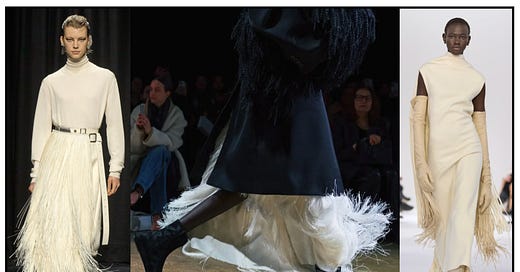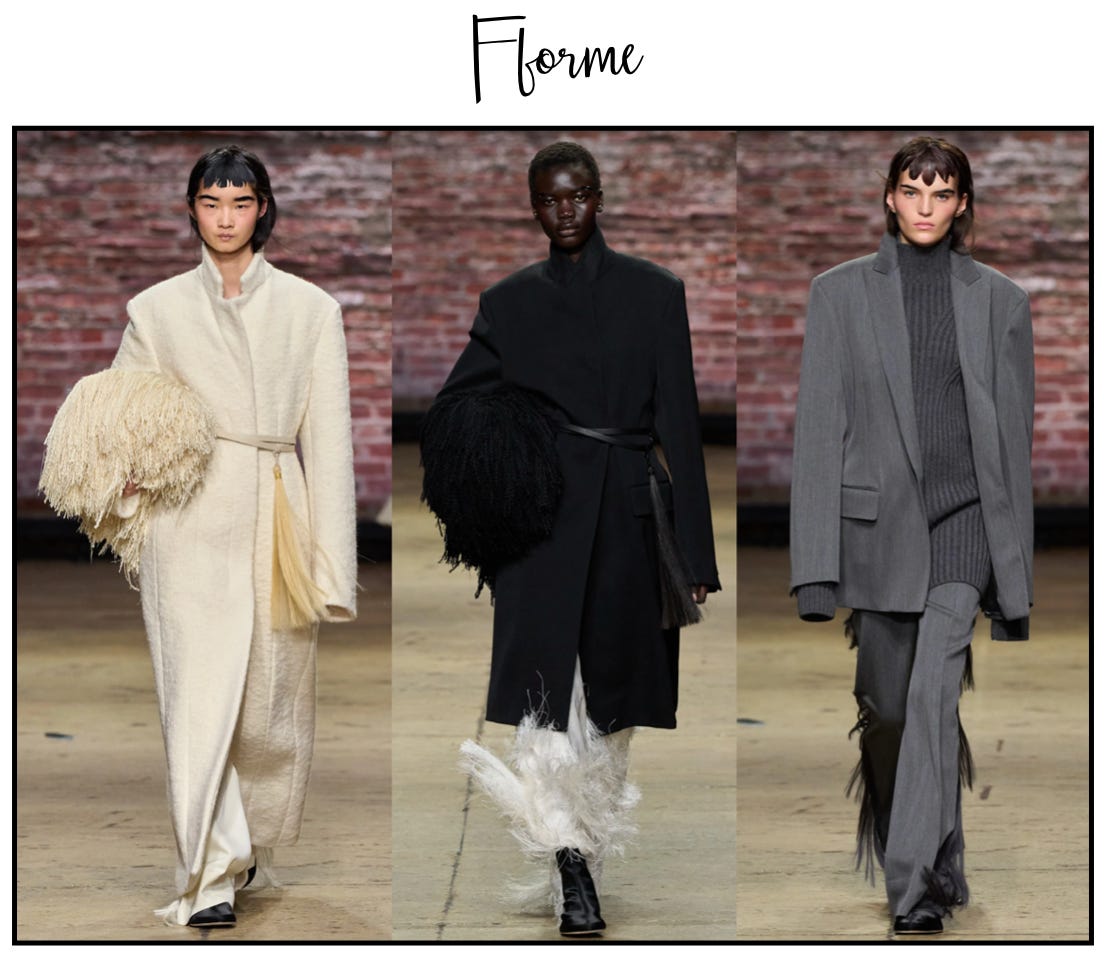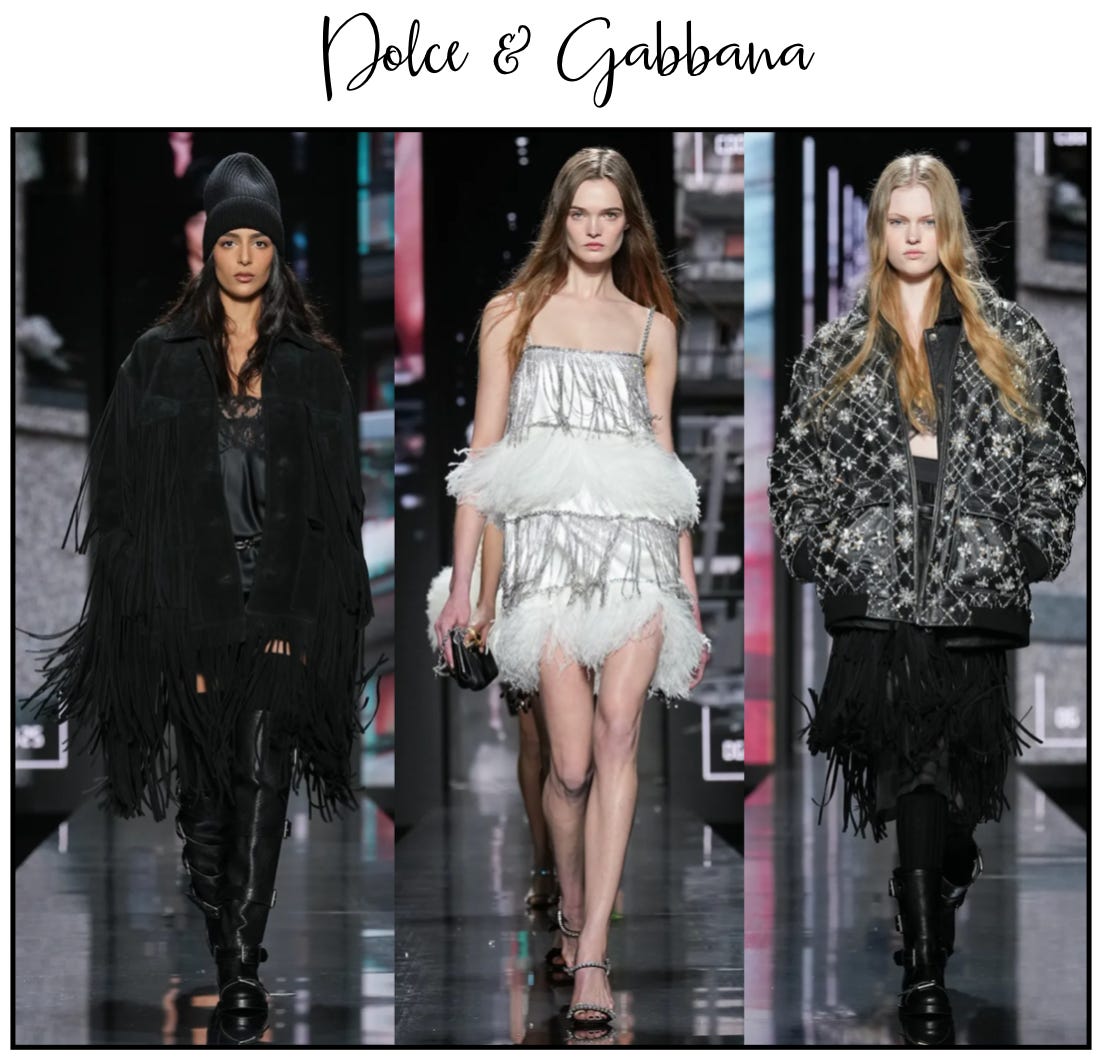Fringe
It would be hard not to notice the liberal use of fringe on the Fall 2025-26 runways. Fforme trimmed skirts and pants with a fine fringe of generous length as well as bags that could double as an emotional support animal, and who doesn’t need that these days.
Sportmax went all in for long leather fringe on everything from gloves, bags, and garments to dramatic effect.
Etro had a strong show that emphasized what they do best; prints and clothes with an artisanal hand. Fringe figured heavily into their story with thick yarn fringe as scarves and trimming chunky knits. Particularly appealing were the fringe-trimmed printed scarves I wouldn’t mind owning myself.
Dolce and Gabbana departed from their usual sex bomb spirit to a more street savvy mood complete with hipster knit beanies and you guessed it, lots of fringe.
The undisputed winner of fringe fest thus far goes to Luke and Lucie Meier for their swan song collection at Jil Sander. Could the heavy use of fringe be symbolic of their now severed relationship with the house? Who knows? Nevertheless, kudos to them for a strong show under what I can only imagine to be difficult circumstances.
If fringed clothing is not your thing, keep an eye out for great fringed accessories. As you can see, they add a lot of verve to a look. From left, Sportmax, Phoebe Philo’s fringed necklace from her latest drop and Tod’s.
Firings
Mass firings are a hot topic of conversation in the US as Elon Musk, the world’s richest man, has been given the power to fire anyone in the federal workforce, despite the dubious legality of this power. For anyone who has ever been “let go” (myself included), the details of the indiscriminate nature and cruelty of the mass firings send chills down the spine. Job security is not something people in the US can count on. In the fashion industry, job security is virtually nonexistent.
The latest round of creative director changes in the first two months of this year is off to a robust start. Sabato De Sarno was fired from Gucci in February, Luke and Lucie Meier’s departure was announced hours after their final show for Jil Sander last week. There are vacancies for the top design spots at Fendi and Carven, with rumors of more imminent changes. This is nothing new, and by now it’s treated like a parlor game to guess who will fill the empty seat.
The topic rarely discussed is the collateral damage often suffered by the entire design team when a creative director is ousted. While the creative director has a contract and is usually well compensated, his or her support team earns far less and is typically not given a generous package when let go. In the US, it’s easy to fire anyone, with or without cause. Europe has more protections for employees, which may shield them when a creative director is dismissed. In the case of Gucci this week, the design team picked up the slack and the show went on without De Sarno. I’m sure the remaining staff worked diligently, clocking long hours. I would be interested to know their fate once a new creative director is named. If anyone can fill me in on the practices in Europe, I would appreciate it.
I know from experience how hard it is to create while managing a heavy workload and hoping you still have a job after pouring your heart and soul into a collection. The hours are long, you work nights and weekends regularly, without extra pay for your time, and willingly do it knowing that a thousand people would love to have your job. Design staff has very little leverage because there is no shortage of talented people looking to get their foot in the door of the handful of top luxury houses.
The truth is luxury houses are not kind to their own. Talent is not nurtured but treated like a commodity. Designers have to deliver and anyone who makes it into a seat at a respected house has earned their place there with talent and hard work. This is especially true for the unknown designers who are not credited for their contributions when all is well, but fall victim to the ax when the tides turn.
I read an excellent piece by Amy Odelle of Back Row titled “Why Luxury Fashion Is Turning Off Rich People”. This spells trouble for the luxury conglomerates as the aspirational customers are increasingly priced out and the ultra rich suffer from buyer’s fatigue. Designer houses were once privately owned businesses selling exclusive products. Now they’re worldwide brands owned by publicly traded companies. It’s grow or die, which compromises the exclusivity of the products.
Much higher prices for designer goods coincide with the dominance of conglomerates in the luxury sector. This is no accident. Higher margins pay for the amped-up marketing, lavish shows, celebrity ambassadors, perks for their VICs (very important customers), return for shareholders, and the lifestyle of the founders. Bernard Arnault, the founder and CEO of LVMH, is the 5th richest person in the world with a family fortune of 186.2 billion dollars.
Deals!
So what can a self-respecting, luxury-loving consumer on a budget do? One solution is to bypass the high margins by shopping for deals. They’re out there, it just takes a lot of digging and an eye for good pieces. With that in mind, I’m introducing a section to my ShopMy store called Luxury on Sale which you can find here. Every week I’ll update it with new deals and provide the link in my usual Sunday post. Paid subscribers will get an early alert on updates and I may make a commission on purchases. This is a new feature of What Looks Good and I would love to hear your thoughts and suggestions for it. Please know that sizes are limited, so if you love something, don’t wait to pull the trigger. I do my best to avoid final sale items, even a great deal is too expensive if it doesn’t work for you. As I’ve said before, I like to have my cashmere and wear it too!
That’s all for now. I greatly appreciate your support and as always would love to hear from you. If the spirit moves you, please share What Looks Good with your friends, family, neighbors, or anyone you think may be interested.
Until next time,
xxx Jolain













Thanks for the interesting read including the link to the Amy Odelle piece. I'd been aware for some years that many high priced fashion pieces aren't always as they seem. I don't know how it works in the US but here, in the UK, just because it says Made in Italy on the label doesn't mean the whole piece is made in Italy. It could have been made in China and the belt and buttons added in Italy . Here in the UK a huge amount of high street fashion comes with a made in China label. And much of it is poorly made and very cheap. Literally throwaway fashion. There are still UK manufacturers but you need to seek them out. When I was a youngster my parents used to take my sister and I to what was called a dress agency. That is selling high class second hand clothes. This was in London and many of the garments came from very wealthy women who despite being very wealthy were still happy to get something for their discarded last season's garments which ofte had only been worn once or twice. There were also lots of sample garments from fashion houses. It meant we got a taste for high quality interesting clothes but at affordable prices. Now in the UK selling on your unwanted garments is a 'thing' but mostly these are not high fashion or couture items but middle range high street stuff. You're as likely to find a couture bargain in a charity/ thrift shop as one selling pre- loved items. Good news about fringes. And if you are into sewing this is something you could add to a garment to customise it for a 2025 makeover.